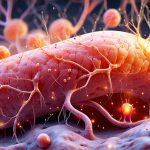The uncomfortable bloating, embarrassing gas, and persistent queasiness many people experience after eating aren’t always due to food sensitivities or digestive disorders in the traditional sense. Increasingly, research points to an often-overlooked culprit: an imbalance within our gut microbiome – the vast community of microorganisms residing in our digestive tract. This intricate ecosystem, composed of bacteria, fungi, viruses, and other microbes, plays a critical role in overall health, influencing everything from immunity and mental wellbeing to nutrient absorption and, crucially, digestion itself. When this delicate balance is disrupted—a condition known as dysbiosis—the consequences can manifest in a variety of unpleasant gastrointestinal symptoms, including excessive gas production and nausea.
Our gut flora isn’t static; it’s constantly responding to various factors like diet, stress levels, medication use (especially antibiotics), and environmental exposures. A diet lacking in fiber-rich foods and fermented products, coupled with chronic stress or antibiotic treatment, can significantly alter the composition of our microbiome, leading to a decrease in beneficial bacteria and an overgrowth of potentially harmful ones. This shift can disrupt the normal digestive processes, causing food to ferment more readily in the colon, resulting in increased gas production and triggering those uncomfortable, queasy sensations that many find debilitating. Understanding this connection is the first step toward restoring gut health and alleviating these frustrating symptoms. If you’re struggling with chronic headaches, it might be time to consider linking gut flora imbalance as a potential trigger.
The Role of Gut Flora in Digestion & Gas Production
The process of digestion isn’t solely our own doing; it’s a collaborative effort between our digestive organs and the trillions of microbes living within us. Beneficial bacteria play a vital role in breaking down complex carbohydrates – like fiber and certain plant components – that our bodies can’t digest on their own. This fermentation process, while essential for extracting nutrients, inherently produces gases as a byproduct. Hydrogen, carbon dioxide, and sometimes methane are common outputs. In a healthy gut, these gases are managed effectively through absorption or elimination, often without causing noticeable symptoms.
However, in cases of dysbiosis, the types of bacteria present can dramatically influence how much gas is produced and its composition. An overabundance of certain gas-producing microbes, coupled with a deficiency in those that help regulate fermentation, leads to excessive gas build-up. Furthermore, alterations in gut motility – how quickly food moves through the digestive tract – can exacerbate the problem. Slower transit times allow more opportunity for fermentation, increasing gas production, while faster transit times may not allow enough time for proper absorption of nutrients or gases. This interplay between microbial composition and gut motility is central to understanding why some individuals experience significantly more bloating and flatulence than others. To proactively support your digestive health, consider creating a daily protocol to strengthen gut flora.
The Connection Between Dysbiosis and Nausea
While gas itself can cause discomfort and bloating, the link between dysbiosis and nausea is a bit more complex. Certain bacterial imbalances can trigger inflammation in the gut lining. This inflammatory response stimulates nerve endings in the digestive tract, sending signals to the brain that are interpreted as nausea or feelings of sickness. Specific metabolites produced by harmful bacteria may also directly irritate the stomach lining, contributing to these sensations.
Beyond direct irritation, dysbiosis impacts the gut-brain axis—the bidirectional communication pathway between our digestive system and our brain. An imbalanced microbiome can disrupt this communication, influencing neurotransmitter production and signaling pathways that regulate nausea and vomiting. For instance, imbalances may affect serotonin levels, a key neurotransmitter involved in regulating mood and digestion; fluctuations of which are often associated with feelings of queasiness. A healthy gut also plays a role in how you handle everyday stress – gut health influences your reaction to social situations and stress levels.
Identifying Imbalances: Symptoms & Testing
Recognizing the signs of gut flora imbalance is crucial for addressing it. Common symptoms extend beyond gas and nausea to include bloating, abdominal pain, diarrhea or constipation (or alternating between the two), food intolerances, fatigue, skin issues like eczema, and even mood swings. These symptoms are often vague and can be attributed to other causes, making diagnosis challenging.
Currently, several testing methods are available for assessing gut microbiome composition. Stool tests, like 16S rRNA gene sequencing, analyze the bacterial DNA present in a stool sample, providing a snapshot of microbial diversity and abundance. Breath tests can also help identify imbalances by measuring the levels of gases produced during fermentation. However, it’s important to note that these tests aren’t always conclusive and should be interpreted in conjunction with a healthcare professional who can consider your overall health history and symptoms. Recognizing gut flora diversity is important for emotional resilience and coping ability.
Restoring Gut Health: Diet & Lifestyle Strategies
The good news is that restoring gut health is often achievable through dietary and lifestyle modifications. A cornerstone of this approach is incorporating prebiotic foods – those containing fibers that nourish beneficial bacteria – into the diet. Examples include garlic, onions, leeks, asparagus, bananas, oats, and apples. Probiotic-rich foods, such as yogurt (with live cultures), kefir, sauerkraut, kimchi, and kombucha, introduce beneficial bacteria directly into the gut.
However, simply adding probiotics isn’t always enough. A holistic approach also involves reducing or eliminating foods that contribute to dysbiosis, like processed foods, refined sugars, and excessive amounts of red meat. Managing stress through techniques like meditation, yoga, or deep breathing exercises is equally important, as chronic stress negatively impacts the microbiome. Finally, minimizing unnecessary antibiotic use can help preserve the beneficial bacteria in your gut. In some cases, a healthcare professional may recommend targeted supplementation with specific probiotic strains based on individual needs and testing results. If you suspect your gut bacteria are overfed, there are ways to rebalance them. Additionally, remember that your gut health significantly impacts motivation to exercise. Finally, be aware of how hormonal birth control alters gut flora and digestion.


















